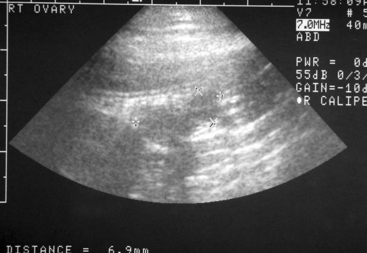15 Disorders of the Ovaries
I. OVARIAN CYSTS
A. DEVELOPMENT
Two types of ovarian cysts have been described in dogs. The most common is the follicular cyst. This is a follicle that develops to the size commonly seen just before ovulation but that does not ovulate or regress. Follicular cysts persistently produce estrogen from the granulosa cells lining the follicle. These cells do not undergo the normal change to luteal cells and do not produce progesterone. Follicular ovarian cysts may be induced to occur by treatment of the bitch with estrogen, as for pregnancy termination (see Chapter 11).
The less common variety of ovarian cysts in dogs is the luteal cyst. Luteal cysts are structures that form after ovulation like normal corpora lutea but that do not regress at the end of diestrus. Luteal cysts persistently produce progesterone. Luteal cysts must be differentiated from cystic corpora lutea; the latter are normal, functioning corpora lutea that develop a hollow, fluid-filled center. These structures may be seen by ultrasound and should not be confused with a pathologic functional luteal cyst (Figure 15-1).
C. HISTORY AND CLINICAL SIGNS
The persistent production of estrogen by follicular cysts causes prolonged clinical signs and history of proestrus or estrus with prolonged bloody vulvar discharge and vulvar swelling and attraction of male dogs. The persistent production of progesterone by luteal cysts may cause infertility or prolonged anestrus. Protracted exposure of the uterus to progesterone may predispose bitches to cystic endometrial hyperplasia and pyometra (see Chapter 16). Many ovarian cysts do not produce significant amounts of either estrogen or progesterone, and these cysts presumably do not alter reproductive function of the bitch.
D. DIAGNOSIS
Diagnosis of ovarian cysts requires demonstration of abnormal persistent hormone production or demonstration of a cystic mass at the area of the ovary. Diagnosis of persistent estrogen secretion usually is made with serial vaginal swabs. Even at high concentrations, estrogen is present in the bloodstream in such small amounts that assay for the hormone in serum is difficult. The characteristic change of vaginal epithelial cells from noncornified to cornified under the influence of estrogen, as described for breeding management (see Chapter 9), is a good bioassay for persistent estrogen production. The longest reported time for normal bitches to be in proestrus and estrus, and therefore the longest time that normal bitches should have cornified vaginal epithelial cells, is 40 days. Any bitch documented to have cornified vaginal cytology for longer than 40 days has persistent estrogen secretion. Progesterone is easily assayed in blood. Normal bitches maintain high concentrations of progesterone in the blood for 60 days after estrus; documentation of high progesterone concentrations beyond that time is indicative of persistent progesterone secretion.
E. TREATMENT
In reproductively valuable bitches, follicular cysts are treated by administration of either gonadotropin-releasing hormone (GnRH), which causes release of luteinizing hormone (LH) from the bitch’s pituitary gland and luteinization or ovulation of the follicle, or of human chorionic gonadotropin (hCG), which acts as LH in the bitch’s body, again causing luteinization or ovulation of the follicle. Luteal cysts are treated by administration of the hormone prostaglandin F2α, which causes breakdown of luteal tissue and cessation of progesterone production. All bitches treated medically should be carefully evaluated for cystic endometrial hyperplasia and pyometra, which are more likely to occur after excessive or prolonged exposure of the uterus to estrogen and/or progesterone (see Chapter 16).
Stay updated, free articles. Join our Telegram channel

Full access? Get Clinical Tree



